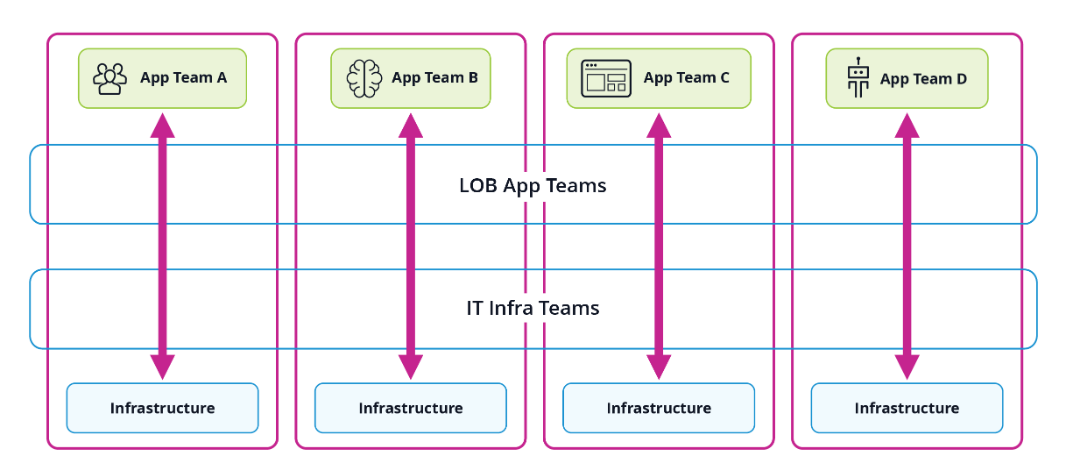What Is Platform Engineering for Networking?

(This content was developed by Futuriom staff and sponsored by Itential. You can read the full report on Applying Platform Engineering Principles to Networking here.)
Infrastructure platform engineering is an important area to watch for its role in facilitating and automating the delivery of infrastructure services for any application, on any platform. In this tech primer we’ll explain elements of platform engineering for networking and how it can be implemented.
Platform engineering provides a common set of self-service tools and workflows for teams to build applications and services. The goal is to identify tools and services that can be built into the platform for teams to employ.
This approach can generate greater efficiency by minimizing the time that teams need to spend selecting and building the tools needed to manage and launch applications and services. It also simplifies work for infrastructure teams by automating deployment processes and improving security and compliance.
Targeting Infrastructure with Platform Engineering
Platform engineering originated in continuous integration and continuous delivery (CI/CD) environments to build and manage cloud-native applications. Instead of having developers exchange files, code, or parts of applications in ad hoc fashion, development platforms enabled code to be managed in a centralized repository using standard tools.

This approach is now being expanded to apply to any applications or services a team might need to manage applications and infrastructure. For example, a development team might require coding tools, observability, networking infrastructure, or compute functions to do their daily jobs. Different teams might be evaluating and implementing a variety of these tools. If an organization can standardize these tools and provide them as self-service options from a central platform, it can drive better efficiencies and make security and compliance easier.
Some of the benefits of platform engineering include:
- Better collaboration and cooperation across business units
- Centralized management and compliance
- Better security and fewer maintenance risks, by standardizing on critical tools (reduction of “shadow IT”)
- Accelerated service and app deployment using self-service standardized tools.
This approach has proven popular in the world of cloud-native infrastructure for a reason. Cloud-based infrastructure has proven to be more agile, scalable, and automated than traditional enterprise infrastructure.
Many companies have started to build teams for platform engineering. By 2026, Gartner estimates that 80% of software engineering organizations will establish platform teams as internal providers of reusable services, infrastructure components, and tools for application delivery.
Just as engineers have proven they can accelerate the deployment of applications using platform processes centered around CI/CD, they can accomplish the same goal with infrastructure using a platform engineering approach and combining it with techniques such as infrastructure as code (IaC).
For example, you could identify commonly used services such as network configuration management, load balancing, or network assurance monitoring – and make them available as a self-service app that anybody can use. At its highest level, think of platform[MJ2] engineering as an abstraction that can help standardize business processes and automation, connecting applications and services to infrastructure.
Keys to Success with Self-Service Infrastructure
As infrastructure becomes more complex with hybrid and multicloud architectures, organizations will want to find areas where they can consolidate several operations at once. Platform engineering holds the promise of delivering on this goal — but it won’t work if it doesn’t include networking, which is key to the entire infrastructure.
The key to platform engineering for networking is to look at common workflows and to identify areas that can be standardized. Then a common set of commoditized services can be built for consumption by the team.
Networking must be used to connect any domain, whether it’s traditional enterprise, cloud, or hybrid. Multicloud, automated networking will be needed to deliver the connectivity need to deliver modern, cloud-native applications along with traditional enterprise apps — but unfortunately networking is often left out of the discussion in the infrastructure planning stages.
Keys to success include the following:
- Deploying standardized infrastructure, abstracted management, and driving continuous operations with software-based automation
- Moving to an “API-first” mindset, rather than depending on CLIs and proprietary management models
- Delivering services and infrastructure using a self-service model.
The key is to identify repeatable, automated processes to create and deploy devices and services that are critical to manage networks.
Read this whitepaper from Itential, developed with Futuriom, which identifies some of the key steps to building networking in conjunction with a platform engineering approach.


















